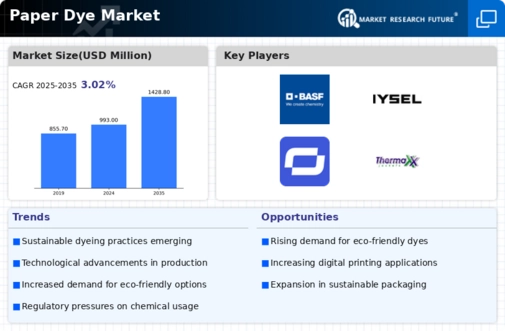Market Share
Paper Dyes Market Share Analysis
The Paper Dye Market, a crucial segment within the broader specialty chemicals industry, witnesses dynamic strategies employed by companies to secure a substantial market share. Within this sector, companies deploy various tactics to differentiate themselves and capture a significant portion of the market.
Product differentiation is a fundamental strategy in the Paper Dye Market. Dyes come in a myriad of colors and formulations, and companies focus on developing unique and vibrant dyes that cater to the specific needs and preferences of different industries. Whether it's vibrant colors for packaging and printing or specialized dyes for artistic and creative applications, differentiation allows companies to carve out a distinctive identity. This strategy not only attracts new customers seeking a wide range of options but also fosters brand loyalty among those looking for specific characteristics in their paper dyes.
Cost leadership is another pivotal strategy in the Paper Dye Market. Given that paper manufacturing and related industries operate within tight budget constraints, companies strive to become low-cost producers of high-quality paper dyes. Achieving economies of scale through efficient manufacturing processes and sourcing cost-effective raw materials enables companies to offer competitive prices without compromising on the quality of their dyes. This cost-effective approach is particularly effective in attracting a broad customer base and securing a significant market share, especially in price-sensitive industries.
Market segmentation is an effective strategy that involves dividing the overall market into distinct segments based on factors such as paper type, application method, or end-use industry. By tailoring their paper dye solutions to the specific needs of each segment, companies can optimize their marketing efforts. This strategy allows for a more targeted approach, addressing the unique requirements of different industries and applications. Consequently, companies can position themselves as specialists in specific segments, attracting a loyal customer base within each and enhancing their overall market share.
Collaborative partnerships and strategic alliances are prevalent strategies in the Paper Dye Market. Companies often form partnerships with paper manufacturers, research institutions, or even competitors to strengthen their position in the industry. Collaborations can lead to shared resources, enhanced research capabilities, and expanded market reach. Joint ventures and mergers and acquisitions are common strategies for consolidating market share, allowing companies to leverage their strengths and offer a comprehensive range of paper dye solutions.
Technological innovation is a driving force in market share positioning within the paper dye sector. Companies that invest in research and development to create advanced formulations and application methods gain a competitive advantage. Being at the forefront of technological advancements not only attracts customers seeking superior and sustainable paper dye solutions but also ensures compliance with evolving industry standards. Staying ahead in innovation helps companies secure a significant market share by offering cutting-edge and environmentally friendly paper dye alternatives.
Geographical expansion is an essential strategy for companies aiming to strengthen their market position. By entering new markets or expanding their presence in existing ones, companies can tap into diverse customer bases and adapt their products to regional preferences. This strategy involves understanding the unique paper dye requirements of different regions and tailoring solutions to address those specific needs. Localized marketing and distribution strategies contribute to successful market penetration, allowing companies to establish themselves as key players in various geographical areas and enhance their overall market share.







Leave a Comment